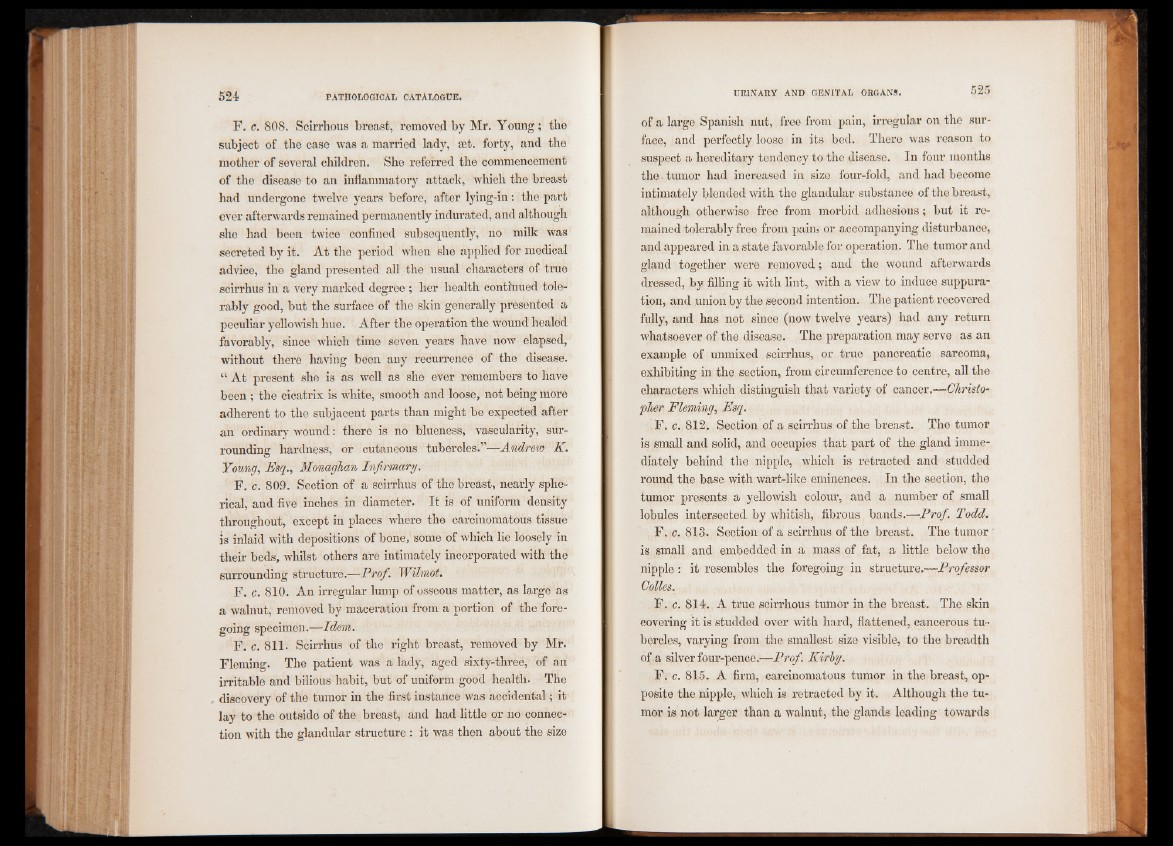
F. c. 808. Scirrhous breast, removed by Mr. Young; the
subject of the case was a married lady, set. forty, and the
mother of several children. She referred the commencement
of the disease to an inflammatory attack, which the breast
had undergone twelve years before, after lying-in: the part
ever afterwards remained permanently indurated, and although
she had been twice confined subsequently, no milk was
secreted by it. At the period when she applied for medical
advice, the gland presented all the usual characters of true
scirrhus in a very marked degree ; her health continued tolerably
good, but the surface of the skin generally presented a
peculiar yellowish hue. After the operation the wound healed
favorably, since which time seven years have now elapsed,
without there having been any recurrence of the disease.
“ At present she is as well as she ever remembers to have
been; the cicatrix is white, smooth and loose, not being more
adherent to the subjacent parts than might be expected after
an ordinary wound: there is no blueness, vascularity, surrounding
hardness, or cutaneous tubercles.”—Andrew K.
Young, Esq., Monaghan Infirmary.
F. c. 809. Section of a scirrhus of the breast, nearly spherical,
and five inches in diameter. It is of uniform density
throughout, except in places where the carcinomatous tissue
is inlaid with depositions of bone, some of which lie loosely in
their beds, whilst others are intimately incorporated with the
surrounding structure.—Prof. Wilmot.
F. c. 810. An irregular lump of osseous matter, as large as
a walnut, removed by maceration from a portion of the foregoing
specimen.—Idem.
F. c. 811. Scirrhus of the right breast, removed by Mr.
Fleming. The patient was a lady, aged sixty-three, of an
irritable and bilious habit, but of uniform good health. The
discovery of the tumor in the first instance was accidental; it
lay to the outside of the breast, and had little or no connection
with the glandular structure : it was then about the size
of a large Spanish nut, free from pain, irregular on the surface,
and perfectly loose in its bed. There was reason to
suspect a hereditary tendency to the disease. In four months
the. tumor had increased in size four-fold, and had become
intimately blended with the glandular substance of the breast,
although otherwise free from morbid adhesions; but it remained
tolerably free from pain, or accompanying disturbance,
and appeared in a state favorable for operation. The tumor and
gland together were removed; and the wound afterwards
dressed, by filling it with lint, with a view to induce suppuration,
and union by the second intention. The patient recovered
fully, and has not since (now twelve years) had any return
whatsoever of the disease. The preparation may serve as an
example of unmixed scirrhus, or true pancreatic sarcoma,
exhibiting in the section, from circumference to centre, all the
characters which distinguish that variety of cancer.—Christopher
Fleming, Esq.
F. c. 812. Section of a scirrhus of the breast. The tumor
is small and solid, and occupies that part of the gland immediately
behind the nipple, which is retracted and studded
round the base with wart-like eminences. In the section, the
tumor presents a yellowish colour, and a number of small
lobules intersected by whitish, fibrous bands.—Prof. Todd.
F. c. 813. Section of a scirrhus of the breast. The tumor
is small and embedded in a mass of fat, a little below the
nipple : it resembles the foregoing in structure.—Professor
Colies.
F. c. 814. A true scirrhous tumor in the breast. The skin
covering it is studded over with hard, flattened, cancerous tubercles,
varying from the smallest size visible, to the breadth
of a silver four-pence.—Prof. Kirby.
F. c. 815. A firm, carcinomatous tumor in the breast, opposite
the nipple, which is retracted by it. Although the tumor
is not larger than a walnut, the glands leading towards